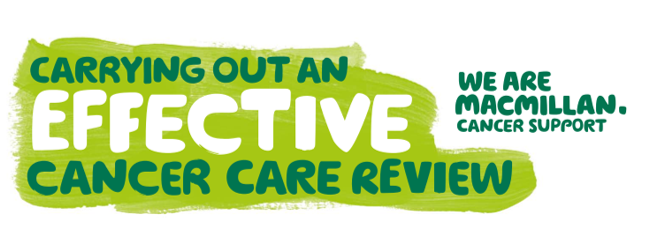Macmillan Resources

Top Tips for GPs - Leaflet reproduced here......
1. Carry out the cancer care review face-to-face
While patients derive enormous benefit from any contact from the practice after a cancer diagnosis, it is often more beneficial for both GP and patient to undertake a Cancer Care Review (CCR) face-to-face rather than on the phone. With increasing numbers of people surviving their cancer diagnosis, cancer follow up in primary care is likely to start to resemble that of other chronic diseases like COPD or Diabetes. You should therefore consider involving your practice nurses in the CCR process at the earliest opportunity.
2. Use a dedicated appointment slot
A good CCR needs its own consultation. Ideally a double appointment, but if not, an initial appointment with a follow up. Setting aside an appointment in this way and inviting the patient to attend sends a powerful message that primary care has a useful role for those affected by cancer.
3. Invite patients to bring a family member, carer or close friend
Having a close friend or family member at the cancer care review may make your patient feel more supported, able to raise important issues, and help them to recall more of the conversation later. You will also get a much clearer idea of the impact the diagnosis has had on the wider family group.
4. Help patients to prepare by sending them information in advance
Patients may be unsure about what the purpose of the review is and whether to bring up particular issues with you e.g. sexual problems or finances. It is often useful to send the patient, either with the invitation or in the days before the appointment, a clear idea of what the purpose of the appointment is, and some examples of topics which they might find useful to discuss. Even better is to consider sending them a
paper version of the Holistic Needs Assessment to complete prior to the appointment – this will help better identify the issues that are important for the patient.
5. Check patients understanding of their treatment and possible late consequences
Ask about and record current or planned treatment with chemotherapy or radiotherapy, include what has been given and in the case of radiotherapy, where it has been given. This is a useful opportunity to check the patients understanding of the purpose of any treatment. The type and location of treatments can have profound implications for the development of treatment consequences in the months and years after
treatment ends.
6. Choose a review template that suits your consultation style
A basic suggested structure is:
- Review medication - Discuss diagnosis, treatment and potential consequences (physical, emotional, social)
- Discuss any financial implications, and provide further information or signpost to further advice and guidance
- Find out about the patients support network and signpost to other sources of support as appropriate
- Agree a date for the next review, or agree that another will happen at points of transition
- Give the patient the opportunity to raise anything else they wish to discuss
7. Find out what advice and support is available for you and your patients
There may be concerns expressed within the CCR which aren’t strictly medical such as financial difficulties, or ones which you feel are outside your area of expertise such as sexual problems or how to discuss the diagnosis with dependents. There is a wealth of comprehensive information produced by Macmillan on different cancer types, treatments, consequences and financial matters. These are available to order online at be.macmillan.org.uk Additionally there are a range of local and national services set up to address these issues, such as the
Macmillan Support Line. Get to know what services your patients can access locally and what the routes to access are.
8. Use the review as an opportunity for health promotion
After a cancer diagnosis patients may be more receptive to high impact health promotion. There is increasing evidence that physical activity can have a significant impact on both physical and psychological health after a cancer diagnosis, as well as reducing the risk or recurrence and the impact of any treatment consequences.
9. Complete the electronic template in the patients’ notes
Macmillan GPs have worked with the main General Practice IT systems including EMIS and Vision (INPS) to produce CCR templates. These can be used as an aide memoir when carrying out a CCR and also provide a helpful record of topics discussed.
10. Consider sharing a copy of the review with the patient’s cancer care team
When you have completed the CCR, consider updating the oncologist or CNS to link in with the Holistic Needs Assessment and to demonstrate
positive working between primary and secondary care to ensure the best experience for the patient.
Copies of this document and other resources are available from be.macmillan
© Copyright Recovery Package